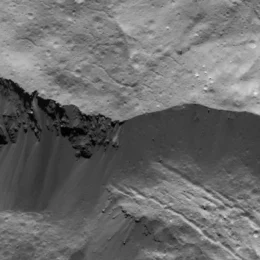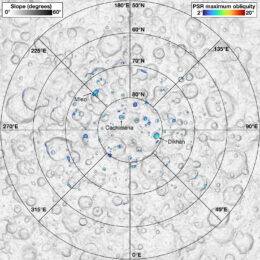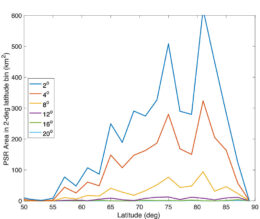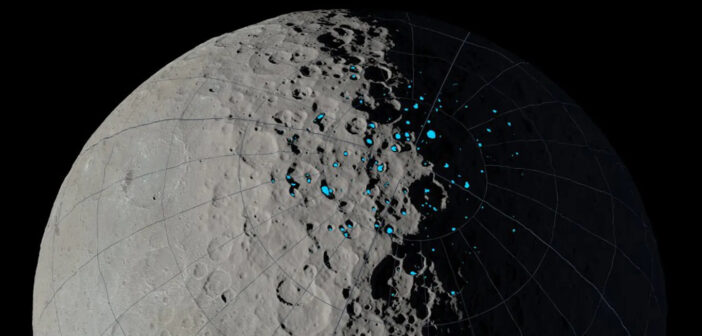Many of the craters on the dwarf planet Ceres are home to deposits of water ice. New research examines the ice-trapping properties these cold, shadowed craters and finds that the ice must be surprisingly young.
Dwarf Planet Discoveries

The Dawn spacecraft captured this image of a crater wall on Ceres from an altitude of about 26 miles (43 kilometers). [NASA/JPL-Caltech/UCLA/MPS/DLR/IDA]
From 2015 to 2018, NASA’s Dawn mission examined Ceres from orbit, reaching an altitude as low as 22 miles (35 kilometers) above the dwarf planet’s surface. Dawn peered into the craters at Ceres’s poles, many of which never see direct sunlight during Ceres’s 4.6-Earth-year orbit around the Sun, and discovered ice on some of the shadowed crater floors. Now, researchers have examined the locations and properties of these ice deposits to estimate how long they’ve been present.

The slope of the terrain surrounding Ceres’s north pole (grayscale) with the locations of permanently shadowed regions colored by the maximum obliquity at which they remain in shadow. Click to enlarge. [Schorghofer et al. 2024]
Crater Considerations
Norbert Schorghofer (Planetary Science Institute) and collaborators used a detailed model of Ceres’s shape based on Dawn data to predict which of Ceres’s craters remain shadowed as its axial tilt, or obliquity, changes. Influenced by tidal forces from the Sun and Jupiter, Ceres’s obliquity varies from 2 degrees to 20 degrees over the course of 24,000 years. The team found that when Ceres reaches its maximum obliquity, there are no crater floors that remain shadowed throughout a Ceres year.
To understand what this means for the history of ice deposits on Ceres, Schorghofer’s team estimated how long it would take for ice on Ceres disappear through sublimation, transitioning directly from solid to gas. They found that when exposed to direct sunlight, ice deposits on Ceres sublimate rapidly, disappearing at a rate of more than a centimeter per year. If sublimation rates were small, that could mean that ice on Ceres could survive for billions of years. Instead, this result means that Ceres’s ice can’t survive long when exposed to sunlight and must be young.
Young Ice

The area of shadowed regions as a function of latitude and obliquity. When Ceres’s obliquity reaches 20 degrees, there are no places that remain shadowed all year. [Adapted from Schorghofer et al. 2024]
Ceres contains a lot of ice hidden under just a few centimeters of rocky surface material, so anything that disturbs the surface, such as landslides or impacts, could expose the ice. The authors find that the most likely source of Ceres’s surface ice is an impact that created a temporary atmosphere that condensed into ice in its craters.
Finally, the authors looked into the possibility of other types of ice, such as carbon dioxide ice, lining crater floors on Ceres. Despite being incredibly cold, Ceres’s craters are too warm to trap gases other than water vapor as ice.
Citation
“History of Ceres’s Cold Traps Based on Refined Shape Models,” Norbert Schorghofer et al 2024 Planet. Sci. J. 5 99. doi:10.3847/PSJ/ad3639

